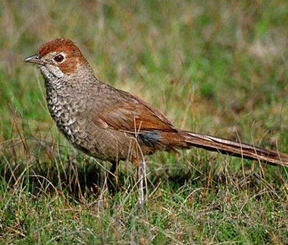Bird watching
Nature lovers will not be disappointed with Peterborough birdlife. The fauna here is mostly ornithological - honeyeaters, southern emu-wrens, superb fairy-wrens, black cockatoos, swamp harriers and the rare rufous bristlebird which lives near the ground amidst sword-grass tussocks and coast beard-heath. This dense vegetation that is open underneath allows the rufous bristlebird to run (they rarely fly) everywhere in safety. Look for the long uplifted tail which jerks upwards and bobs about as it runs through the grasslands.Peregrine falcons as well as the magnificent wedge-tailed eagle (Australia's largest bird of prey) can sometimes be seen flying above the cliff-tops. Pelicans, ducks, black swans, spoonbills and egrets inhabit the estuaries and wetlands.
Penguins, terns and white dotterels can generally be found near the shore and hooded plovers nest in very exposed beach locations so watch for eggs when walking above the high tide line.
Australasian gannets, wandering albatrosses and short-tailed shearwaters (or Mutton birds, as they are often known) can be seen out to sea. Muttonbird Island, near Loch Ard Gorge, is an important nesting place for the Muttonbird. These remarkable birds migrate about 30,000 km every year, spending summer in the northern Pacific Ocean and returning the last week of September to nest in various rookeries in Bass Straight. You can watch them fly ashore each evening from October to April, although the best viewing is January to February.
Penguins spend nearly all day at sea hunting for food in groups known as 'rafts' but start coming home to their burrows just before dusk, so the best time to see them is as the sun sets. A colony of about 1000 birds can be found at the 12 Apostles and can be viewed from a distance of approximately 60 metres. Alternatively you will find a colony of 80-100 birds at London Bridge with viewing distance from between 20 to 60 metres. For more information, please call 1300 137 255.






